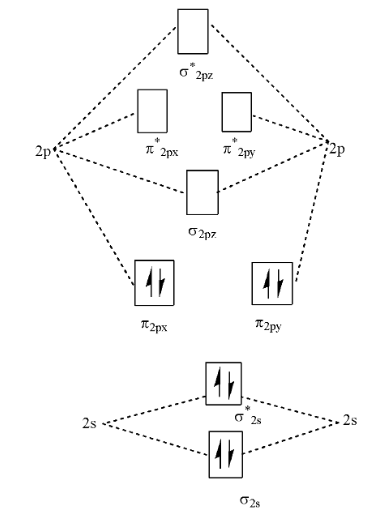
Answer
465.6k+ views
Hint: We should know that \[C{{N}^{+}}\] which is a Cyanide radical (which is also called as nitride carbon (1+)) is a diatomic molecule. And for a bond order measurement, we need to enumerate the number of electrons involved in a particular bond in a molecule.
Complete step by step answer:
> It is highly imperative for you to understand the structure before finding out the bond order for a particular molecule.
> Bond order as we all should know or perhaps know is the measurement of the number of electrons involved in bonds between two atoms in a molecule. It primarily indicates the stability of a chemical bond.
> We should also know in this context the bond strength is directly proportional to the bond order of the molecule.
> There are multiple ways to depict a chemical compound through various theories such as Molecular orbital theory or Valence bond theory. But for the sake of understanding the solution, let us explore the solution through a typical Lewis Structure which is shown below:
${{C}^{+}}\equiv \underset{{}}{\overset{..}{\mathop{N}}}\,$
> We can also look at the molecular orbital diagram of the given molecule. i.e.

> Additionally to this chemical structure, we should know that Carbon has 6 electrons and Nitrogen has 7 electrons. We also need to consider a -1 for a positive charge on the cyanide radical. Hence the number of electrons in the given structure is: 6+7-1 which is 12 electrons.
> Now there is a trick involved here, that any species with 14 electrons will have a bond order of 3. For every increase or decrease of 2 electrons, the bond order decreases by 1. So, for our problem, we have a number of electrons equal to 12, hence the bond order we would have for the Cyanide radical would be 2.
- The Bond order for \[C{{N}^{+}}\] is 2.
Note:
1- Now, there are different ways through which you could come to your solution. The other elaborate way to do this is through Molecular Orbital Theory, in such a case you need to calculate the number of bonding electrons as well as the number of anti bonding electrons.
2- The formula would be:
\[\frac{(number\_Bonding\_electron)+(number\_antibonding\_electron)}{2}\]
Where antibonding electrons are the one which are outside the region between two nuclei.
Complete step by step answer:
> It is highly imperative for you to understand the structure before finding out the bond order for a particular molecule.
> Bond order as we all should know or perhaps know is the measurement of the number of electrons involved in bonds between two atoms in a molecule. It primarily indicates the stability of a chemical bond.
> We should also know in this context the bond strength is directly proportional to the bond order of the molecule.
> There are multiple ways to depict a chemical compound through various theories such as Molecular orbital theory or Valence bond theory. But for the sake of understanding the solution, let us explore the solution through a typical Lewis Structure which is shown below:
${{C}^{+}}\equiv \underset{{}}{\overset{..}{\mathop{N}}}\,$
> We can also look at the molecular orbital diagram of the given molecule. i.e.

> Additionally to this chemical structure, we should know that Carbon has 6 electrons and Nitrogen has 7 electrons. We also need to consider a -1 for a positive charge on the cyanide radical. Hence the number of electrons in the given structure is: 6+7-1 which is 12 electrons.
> Now there is a trick involved here, that any species with 14 electrons will have a bond order of 3. For every increase or decrease of 2 electrons, the bond order decreases by 1. So, for our problem, we have a number of electrons equal to 12, hence the bond order we would have for the Cyanide radical would be 2.
- The Bond order for \[C{{N}^{+}}\] is 2.
Note:
1- Now, there are different ways through which you could come to your solution. The other elaborate way to do this is through Molecular Orbital Theory, in such a case you need to calculate the number of bonding electrons as well as the number of anti bonding electrons.
2- The formula would be:
\[\frac{(number\_Bonding\_electron)+(number\_antibonding\_electron)}{2}\]
Where antibonding electrons are the one which are outside the region between two nuclei.
Recently Updated Pages
Identify the feminine gender noun from the given sentence class 10 english CBSE

Your club organized a blood donation camp in your city class 10 english CBSE

Choose the correct meaning of the idiomphrase from class 10 english CBSE

Identify the neuter gender noun from the given sentence class 10 english CBSE

Choose the word which best expresses the meaning of class 10 english CBSE

Choose the word which is closest to the opposite in class 10 english CBSE

Trending doubts
Sound waves travel faster in air than in water True class 12 physics CBSE

A rainbow has circular shape because A The earth is class 11 physics CBSE

Which are the Top 10 Largest Countries of the World?

Fill the blanks with the suitable prepositions 1 The class 9 english CBSE

One Metric ton is equal to kg A 10000 B 1000 C 100 class 11 physics CBSE

How do you graph the function fx 4x class 9 maths CBSE

The Equation xxx + 2 is Satisfied when x is Equal to Class 10 Maths

Give 10 examples for herbs , shrubs , climbers , creepers

Change the following sentences into negative and interrogative class 10 english CBSE




